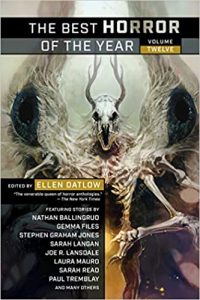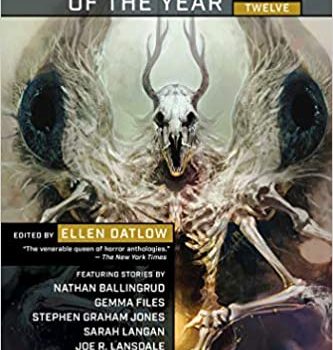Paula Guran Reviews The Best Horror of the Year Volume Twelve, Edited by Ellen Datlow
 The Best Horror of the Year Volume Twelve, Ellen Datlow, ed. (Night Shade Books 978-1-59780-973-3, $15.99, 480pp, tp) October 2020.
The Best Horror of the Year Volume Twelve, Ellen Datlow, ed. (Night Shade Books 978-1-59780-973-3, $15.99, 480pp, tp) October 2020.
Ellen Datlow’s career as the doyen of “year’s best” editors began with The Year’s Best Fantasy: First Annual Collection in 1988 (with co-editor Terri Windling), and the series was renamed The Year’s Best Fantasy and Horror with the third annual collection. After 21 volumes, the series ended, but Datlow continued with 2009’s The Best Horror of the Year Volume One. We’ve now arrived at the 12th entry. If you combine the two series, only the late Gardner Dozois and his The Year’s Best Science Fiction series has (with 35 volumes) a longer history. Datlow unfailingly presents notable scary tales and – since her choices come from an immense variety of sources – even avid readers are unlikely to have encountered them all. This year is no different; she offers 22 stories and novelettes and one novella first published in 2019. Datlow also includes an annual “summation” of the year in horror and a list of “honorable mentions.”
Frankly, many of the selections were top candidates for my own The Year’s Best Dark Fantasy and Horror: Volume One (11th in the series), but Datlow got to them first.
Among my personal favorites are two stories with maternal protagonists: “Playscape” by Diana Peterfreund (another mother’s child disappears and the mother is suspected) and “The Night Nurse” by Sarah Langan (an overtaxed Brooklyn mother acquires a night nurse who admits to being a witch).
Joe R. Lansdale’s “The Senior Girls Bayonet Drill Team” is another stand-out. His dystopic future high school competition is not that far removed from current reality. In the “The Puppet Motel” by Gemma Files (from Datlow’s own Echoes: The Saga Anthology of Ghost Stories), the lead character senses a beckoning tone of wrongness in a luxe apartment in a new high rise.
A film crew encounters evil in Kristi DeMeester’s “A Song for Wounded Mouths”; the horror comes from the choice to succumb or defy it. Then there’s Daniel Braum’s moving “How to Stay Afloat When Drowning”, which delves into the depths of loss, and Robert Shearman’s droll and dark “I Say (I Say, I Say)”.
I missed other stories altogether and delight in discovering them here: “The Pain-Eater’s Daughter” by Laura Munro with its theme of all gifts coming with a cost, “Mr. and Mrs. Kett” by Sam Hicks (in which a “marvelous” couple – perfect guests – change a family forever), Simon Bestwick’s “Below” (which explores unknown levels of 1986 Manchester), and the pair of siblings who must deal with a strange family house in “Slipper” by Catriona Ward.
This is a perennial must-read for anyone who enjoys dark fiction.
Paula Guran has edited more than 40 science fiction, fantasy, and horror anthologies and more than 50 novels and collections featuring the same. She’s reviewed and written articles for dozens of publications. She lives in Akron OH, near enough to her grandchildren to frequently be indulgent.
This review and more like it in the December 2020 issue of Locus.
 While you are here, please take a moment to support Locus with a one-time or recurring donation. We rely on reader donations to keep the magazine and site going, and would like to keep the site paywall free, but WE NEED YOUR FINANCIAL SUPPORT to continue quality coverage of the science fiction and fantasy field.
While you are here, please take a moment to support Locus with a one-time or recurring donation. We rely on reader donations to keep the magazine and site going, and would like to keep the site paywall free, but WE NEED YOUR FINANCIAL SUPPORT to continue quality coverage of the science fiction and fantasy field.
©Locus Magazine. Copyrighted material may not be republished without permission of LSFF.







